Check this page again tomorrow for updates, and in the meantime check my stories on Instagram at @SebastienPlus 🙂
I’m on Sado Island (Niigata Prefecture) to enjoy its annual music festival Earth Celebration, especially Kodo’s concerts on the evenings of Friday 16, Saturday 17 and Sunday 18 August. One will feature a collaboration with an Ugandan group playing an instrument that I’ve never seen nor heard live. Here is how it sounds & looks:
I attended a full Earth Celebration 15+ years ago with a friend, which remains my number 1 memory related to events in Japan. I’m consequently very excited to attend this 2024 edition 🙂 Check the Earth Celebration website!
Note: My client Yuranza (as business development manager for Japan Travel KK) is led by a former member of the taiko group Kodo which is at the centre of the Earth Celebration annual music festival so I’m even more connected to this event.
Backstage Tour At The Venue
Helping promote the event over the years, our group of travel professionals was invited to an exclusive backstage tour so we could see the setting during & between rehearsals, discuss with staff and a Kodo performer, and even go on stage to see how everything is set up (e.g. microphones attached to musical instruments) and to see how the audience would look like from the performers’ perspective during the concerts. We’ll try to sell such a tour to travellers attending the concert in 2025 & beyond.
Also, we discussed with a Kodo founder about Kodo’s history and about the plans for the upcoming 40th anniversary of the group, and there may be a performance at the shrine (Shiroyama Park?), maybe even with a 360-degree stage without amplification for a shared, natural performance close to the roots. We also discussed about the logo of Kodo, which represents a spiral/whirlpool/power, twisted like twined ropes, expressing a mix of elements, keeping the power within the drum. He also told us that the most important/special part of the Kodo training is living together, growing rice, cooking… and Kodo focuses on living, learning, and creating.
And during a tour, we could consider having a day guided by that founder, who spoke very good English.
Concerts
The 3 evening concerts take place at the same venue, with English/Japanese announcements, and with seats labelled SS (front/premium), S (middle) or A (back). The SS audience sits on the ground rather than on chairs thus feeling the vibrations of the drums through the whole body, and can see minute movements of the performers (e.g. sliding a stick put flat on the drum skin while hitting with another stick in order to gradually change the sound produced). Of course, one can bring a ground-level seat to have a support for the back. Filming & photographing are forbidden during the concert except the final “Encore!” part, unless one has a special Media/Press authorization. The concert venue was just beside the sea so you may enjoy a beautiful moon and sunset.
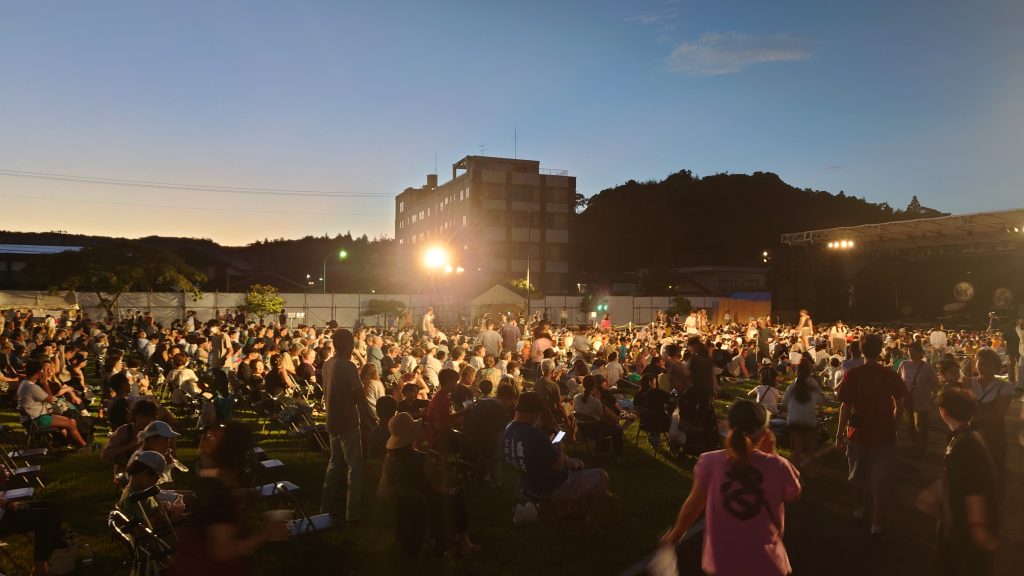
What sets Kodo concerts apart? This year, I felt that:
- Kodo performers are storytellers in a language that we can all understand.
- Kodo performers tell a story with each other rather than telling the same story in the same way like a chorus.
- The stage is very simple, without glitter or decorations distracting from the performers’ skills, movements and sounds.
Concert “Reunion” (Day 1)
Successfully crowded (how many people attended?), this first concert of 2024 Earth Celebration started with lights & shadows before sunset and with beats of a female Kodo performer. Diverse instruments were used including flutes, cymbals… and unusual instruments like a pack of nuts (?) and an electronic drum (surprising & mesmerizing effects controlled by feet for a powerful, complex and masterful solo performance by Masayuki Sakamoto). The theme “Reunion” reflects the presence & performance of 4 former Kodo performers currently successful as solo artists.
During the first half of the concert, my favourite sight was that of a drummer leaning over a giant drum to beat it with a giant stick. The most surprising? At several moments, the music stopped and the audience started to applaud but the music resumed in a different way, like a ball thrown in the air that seems to stop just before falling down.
I deeply enjoyed the second half of the concert, which started more crystalline, with a night sky and blue hues, voices, hums of vibrating metallic bowls, and fingers replacing sticks when beating drums! It also included humorous movements and sounds of hand cymbals by Ryutaro Kaneko. And excitingly for those without SS seats, some performers reached the stage by walking and playing among the audience from the back. Overall, that half demonstrated the showmanship of Kodo, which led to the whole crowded clapping rhythmically.
Interestingly for those who believe that Kodo is just about big taiko drums, the 3 big drums were played only during the last quarter of the concert…
Concert “Tataku” (Day 2)
Kodo’s second concert “Tataku” was performed in collaboration with the Ugandan guest group Nakibembe Embaire, with a strong focus on a giant Ugandan xylophonic and the presence of smaller sylophones played by some Kodo musicians. These guest appearances make each edition of the Earth Celebration unique, and attract repeat audiences to Sado Island. This summer evening was relatively cool & comfortable thanks to clouds hiding the sun while keeping a big blue sky visible in other directions.
The concert started with a daytime parade of 5 men & women among the audience, with a leader waving colourful ribbons attached to hand fans, joined on stage by drummers and flute players wearing unicolor uniforms of diverse colours, and rapidly after by a flag bearer waving a giant flag illustrated with waves, a lucky sea bream, and Kodo’s logo. 2-3m high washi paper was visible in the background, changing colour according to the lights.
Just after, the Ugandan group (6 players) played their giant xylophone and sang, accompanied by dancers with types of masks I saw for the first time, sometimes waving leafy branches as accessories (reminiscent of some Shinto rituals), sometimes holding and moving a giant veil over the musicians. The Ugandans later danced on Kodo’s drum beats. The first half of the concert felt very short because it was so exciting & successful 🙂
The second half of the concert was participative, with knowledgeable members of the audience dancing in a specific way, others (like me) just clapping hands, during a song & dance with kimonos, triangular hats, Japanese lanterns, a shamisen… It was also more slow-paced and more quiet. The last piece of the concert featured big drums.
Other notable aspects of the concert included:
- The playing of 3 large drums by 6 players, each playing on a different side!
- An exciting visual as 3 Kodo members had longs sticks fixed to their backs, and bowed suddenly & deeply to hit the floor with the sticks, producing a nice complementary sound.
- The Ugandans initially wore black western suits then white robes.
- One Ugandan played his section of the xylophone while turning his back on it!
- A performer wearing clothes with very long sleeves and a hat veiling his/her face in all directions danced in a way reminiscent of a ghost or jellyfish (I hope the performers would not be offended by that impression).
The “encore” final performance was an exciting collaboration with the Ugandan guests that ended like seen in the following video:
Concert “Shukusai” (Day 3)
The third/final concert started with a female drummer and quickly continued with 14 musicians! It was very drum-intensive, very physical, but a whistle could also be heard a few times 🙂 That was really a performance during which you can forget everything else!
Highlights included:
- The Ugandan performers sang and played the xylophone that day too, wearing red tee-shirts this time.
- A Kodo singer sang alone accompanied by the sound of waves, then with a companion, ending with a chorus of 10+ singers.
- The final highlight of this concert was a very impressive, almost naked (only headband + “fundoshi” loin loth), very muscular drummer playing a huge wadaiko, elevated and surrounded by lanterns; he started solo then was accompanied by 3 drummers.
Very special for me: I had the pleasure to meet and shake hands with one of the Ugandan performers during the intermission, thanking him for coming all the way to Japan.
Complementary Shops & Events
A water fountain, roofed seats/benches, toilets, and diverse temporary shops (foods, drinks, artworks, clothes…) can be found just beside the concert venue. Some foods are vegan & gluten-free, for example Shizuoka City ganmo.burger‘s burgers with Genovese-shiso sauce or mustard sauce. The mustard-sauce burger contains a rice patty and mustard between slices of tofu mixed with sesame, carrots and lotus! Pretty good and very light. The Genovese-shiso is similar, with a lighter taste (I recommend the mustard one). Unexpectedly, a popular food was an ice cream with olive oil and black pepper at the truck labelled “Nancy Johnson” (in memory of the inventor of homemade icecream).
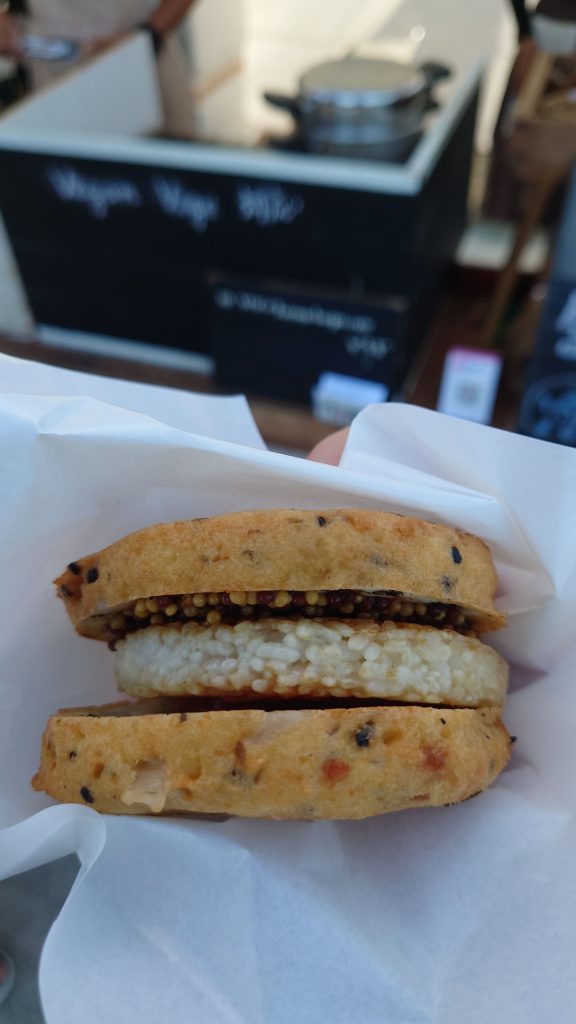
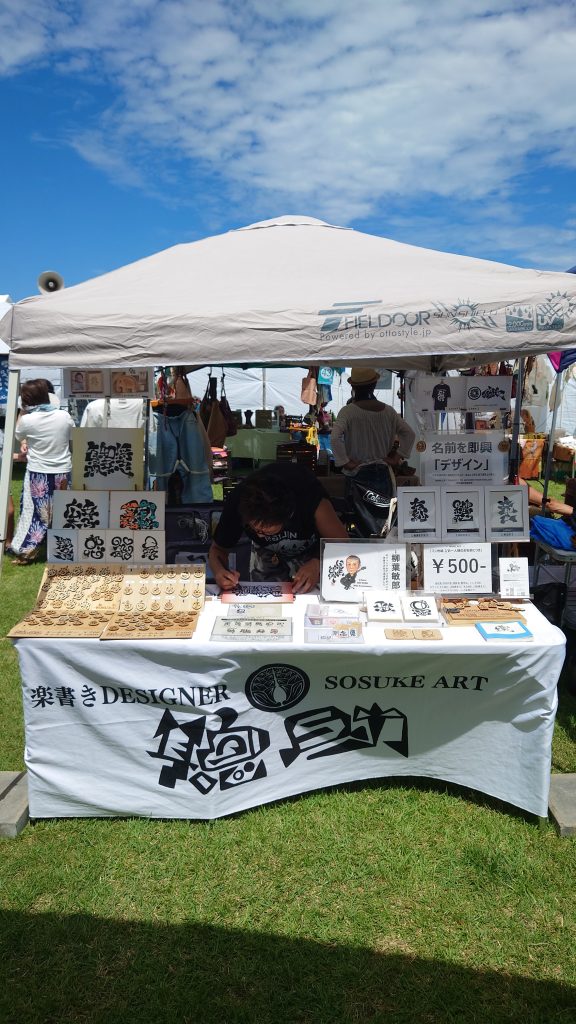
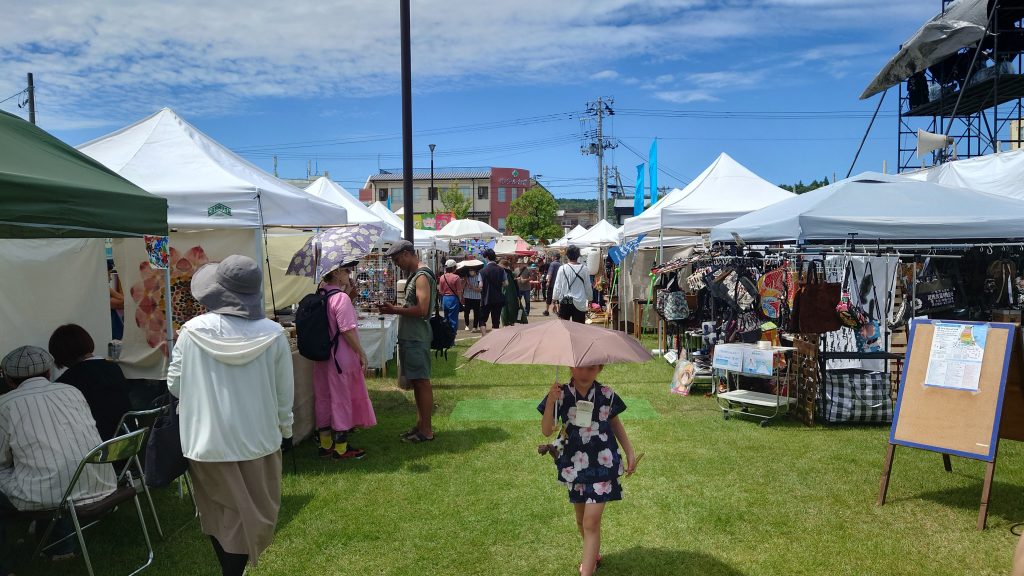
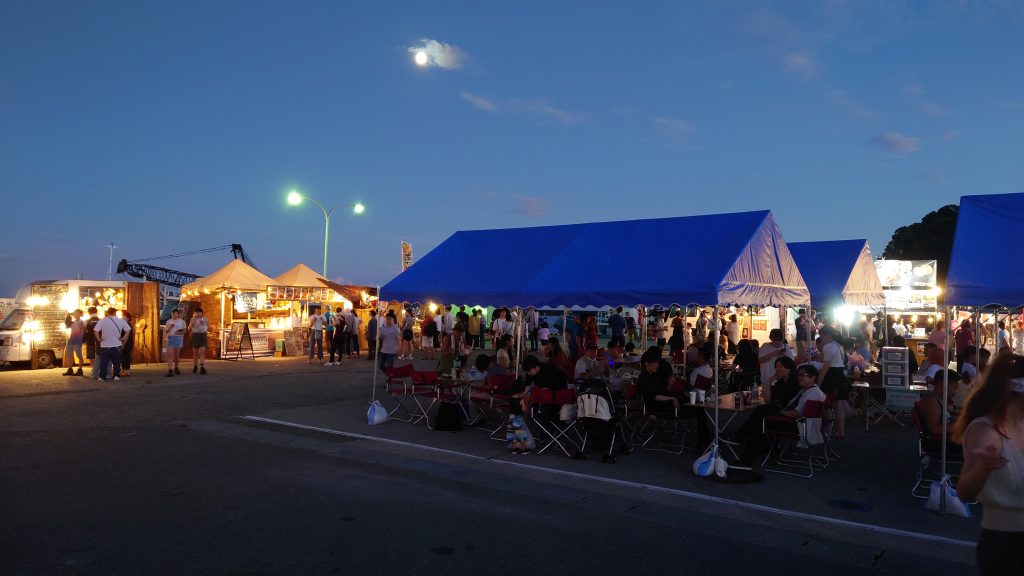
There are also traditional events taking place such as a short but popular wadaiko parade starting in Ogi shopping street and finishing at a local Shinto shrine, a traditional Ogi Okesa Dance Circle (including children in kimono and with foreigners welcome to join) in the same street, and demonstrations of Ogi Folk Performing Arts at Shukunegi Community Hall (the fertility dance did “surprise” a few members of our group 🙂 — there were songs too). Each village on Sado Island has a demon drum dance (onidaiko/ondeko) with its own unique style to drive evil spirits away, and to get good harvests, large fishing hauls, etc.